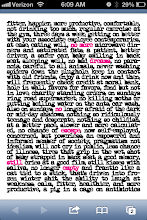In the beginning pages of Kernan's work, he expresses the anxieties that many people had in the 16th-18th centuries about the defamation of art and literature. There were many reasons for this as to why there was such a resistance to mass-produced printing. First, new mass-produced printing could allow the book to be distributed everywhere and anywhere, allowing people from all walks of life to enjoy literature. Second, in order to do so, this often meant translating books into the vernacular, changing their original form. This may seem like an really awesome thing at first, but the way I imagined it was like copying a painting. Paintings always seem to hold a higher value in our minds than literature, so this example helps to think how they were thinking (and our views of literature as not being "high art" may be a result of this time period and the mass production that made it available to all.) When somebody thinks of a painting, they usually always think of it in its original form and copies are thought of as just that, copies. The copies never hold as much value as the original and nobody wants a copy of a Picasso or Norman Rockwell piece. To make copies of this (even though it is done), is not thought of highly. This is the way that people thought of copying the Greek and Latin classics of the time. These were considered "high art," and to take them out of their original form through mass production was not accepted. This is like carrying around a credit card with VanGhogh's "Starry Starry Night" and acting like you really had a copy of it. This made something exclusive and turned it into common property. The book became commodified and democritized.
Another reason for this resistance that seems almost obvious is the standard resistance to cultural change. Any time things start to change in a society, there are always those who oppose it and do not want it to happen. The shift that was occuring, which we talked about extensively in relation to Addison and Steele, is the shift from an aristocracy to a more modern class system where people did not come to wealth only through family relations and marriages. More people had more money, the middle class was emerging, and a whole new literary culture was emerging, inviting a whole new arena of tastes and responses, all of which were not accepted with open arms. Literary cannons were no longer part of this aristocratic social structure and no longer served as part of the foundation as they once were. Once again, the mass production of the book changed the way people looked at literature and changed the way that literature was used as a marker of social status.
Tuesday, February 24, 2009
Subscribe to:
Post Comments (Atom)




Carissa, I really enjoyed your blog. I also compared visual art to the art of literature. I think it's important to make art available (even by copy) to those who can't afford it. Knowledge should be made commonplace.
ReplyDeleteYeah definitely....and I didn't get into this in my blog, but I think that's what Johnson was really trying to do. By making the dictionary he was creating a place for collective knowledge that anyone could have access to. i guess even our blogs are kind of a place of commonplace, collective knowledge...all in the spirit I suppose :-)
ReplyDelete